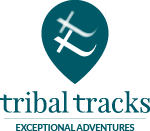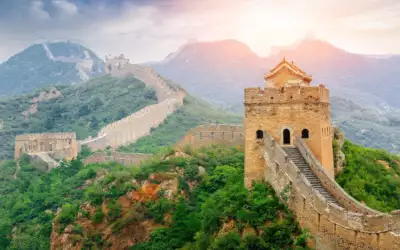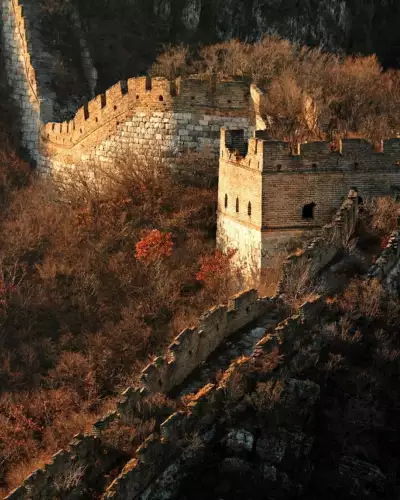Loved it - the best way to catch up with friends, challenge yourself and explore a beautiful country.
Felix H
Location
Terrain
Difficulty
Accommodation and Meals
Hotel, Guesthouse
Duration
10
Meeting Point
London/Beijing
Annual Leave
6
Group Size
16
Seasons
March-May, September to November
Walking Distance
30km approx

An immersive and culturally enriching multi-day trek
An in-depth exploration of one of the New Seven Wonders of the World
Explore five different sections of the wall - experiencing changing scenery including mountains, forests and vast plains
Stay in authentic local farmhouses, enjoying interactions with local residents to add to the authenticity of the adventure.
Enjoy genuine local Chinese cuisine
All the info you need
Trip Details
This multi-day trek visits five unique sections of the Great Wall of China. Due to the undulating and sometimes tricky terrain, it's fairly physically demanding, although with appropriate training at home, it can be considered 'less challenging' than many of our treks. You will not be 'on' the wall at all times; instead, you will walk next to it. Prepare for grassy/rocky terrain.
You need a visa to visit China. As it stands, you will need to visit a China Visa Application Center in person about three months before departure (London, Manchester, Edinburgh, Belfast) to obtain this, this may change and we will update you closer to the expedition.
They will require a printout of the outbound and return flight confirmation, an invitation letter and a printout of your booking (we will supply these). You also need to take your passport with you.
Faith in Families is transforming lives across Swansea Bay through our Community Cwtches & Multibank. We provide vital support to children and families facing challenges such as poverty, crisis, and trauma. Our wide range of services includes parent and toddler groups, 1-2-1 child therapy, parental & child support, outreach work & home support. Established in 1999, Faith in Families has grown to encompass three community cwtches in the Swansea area. Each setting based in deprived areas of Swansea, aiming to provide help and support to families within the community. We also run Wales’ first multibank.





Trip Details
Trek along one of the world's most iconic manmade structures, experiencing fascinating culture and delicous cuisine throughout.
By embarking on this trek, you'll gain a much more comprehensive insight and a better understanding of the wall's historical context and significance than a typical day visit, and you'll be able to explore the changing scenery and landscapes of each section of the wall that we will visit, not to mention the sense of achievement for pushing yourself to take on this trekking adventure. We will have plenty of time to explore the watchtowers, beacons, statues, and other architectural features en route without being rushed on as you would in the busier tourist hotspots of the wall.
At night, we will retire to our farmhouses or guesthouses to learn more about the lifestyle of the local residents and taste some delicious Chinese cuisine.
The trek is bookended by guided tours of Beijing to include all of the typical (but nonetheless impressive) highlights, as well as some free time to explore on your own.
Please note - sections of the wall could be closed by the Chinese authorities at any time, often with short notice. If this happens, we will seek out alternative comparable routes or activities.
Flights are included on this expedition. You will be met by your Tribal Tracks Expedition Leader at the airport in the UK
Accommodation and Meals
NA- overnight flight
Arrive Beijing
When we arrive in Beijing, China's political and cultural centre for more than 700 years, we'll transfer to our hotel. We'll get checked in and comfortable before visiting the local theatre to see an acrobatics show. After this, we will have our first team meal together.
Accommodation and Meals
Hotel, dinner
See the highlights of Beijing
This morning, we will be guided around the main unmissable attractions in Beijing. These include the Forbidden City, the moat-surrounded palace of 24 Chinese emperors for nearly 500 years, and an architectural marvel that showcases traditional Chinese palatial construction at its finest. We'll also visit the UNESCO World Heritage site - the Temple of Heaven, where emperors visited for annual ceremonies of prayer to Heaven (to pray for good harvests). The building's design reflects cosmological and philosophical beliefs.
No visit to Beijing would be complete without visiting Tiananmen Square, where a series of events and protests calling for political reform in 1989 ended in a violent crackdown and a profound long-term effect on China's political landscape.
Later in the afternoon, we will transfer to the mountains - the gateway to our Great Wall Trek.
Accommodation and Meals
Local guesthouse, full board
Taipingzhai to Quiangang ancient village via Huangyaguan. Trek 10km/6.5 hours
The start of our Great Wall Trek is Taipingzhai. We'll have a short drive from our accommodation to the start point and will be instantly rewarded with stunning views. The wall stretches far into the distance, and this is the distance we will cover today, and beyond.
Be prepared to walk up and down a lot of steps. When we say a lot of steps, we mean a lot of steps! The first part of today's walk will be on a beautifully maintained section of the wall, crossing over the village of Huangyaguan and onto the Huangyaguan section of the wall. You guessed it, more steps, including the 'Sky Ladder' — 302 near-vertical steps (there is a handrail!). We'll stop for a packed lunch near the top of the Sky Ladder before continuing.
The further we travel on today's journey, the more remote and rugged we'll feel, and the more unstable the terrain will be underfoot. We continue the trek to an ancient and completely unrestored section of the wall, where it is unlikely we will see any other visitors. We have a steep descent on very rocky ground to the end of today's trek- Quiangang ancient village. We have a short drive back to our accommodation, split between cars as the road is unsuitable for busses.
Before lunch:
Distance: 2.5 km, 2 hours, total climb: 193-260m, Total descent: 377-442m
After lunch:
Distance: 7.5 km, 4.5 hours, total climb: 700-900m, Total descent: 600-1000m
Accommodation and Meals
Local guesthouse, full board
Trek 4.5km/3-4 hours
Transfer North for 2 hours to begin trek.
This is the shortest distance day on the oldest section of the Great Wall from the Ming Dynasty. It is completely unrestored and wild. The challenge here is a steep ascent at the start of the day, with lots of loose rocks on the descents. It's unlikely you will see anyone else on this day. The trek finishes with a walk through farmland and blossoming fruit orchards.
Distance: 4.6 km, 4.5hours, Total climb: 389 - 450m, Total descent: 301-350m
Accommodation and Meals
Local Farmhouse, full board
8km / 5 hours
This section of the Great Wall, approximately 10km end to end features a mix of restored and unrestored sections, so you'll get a glimpse of the wall's original state. It was designed as a vital defence system, to protect the northern borders of China from invasions by nomadic tribes. There are some steep climbs on this section and the terrain is uneven but once again, you will be treated to awe-inspiring views in every direction, including views of Beijing. Be prepared to walk up and down a lot of steps again!
Accommodation and Meals
Local farmhouse/ full board
Trek 5.5k, 4 hours then 3.1k, 3 hours
Gubeikou (originally named 'Beikou' - 'Northern Pass') is known for its rugged beauty. It traverses a rugged and mountainous landscape and has never been reconstructed. It's often considered as the 'wild' Great Wall, but it is an easier walk than yesterday.
After a filling lunch, we will continue our Great Wall Trek by climbing to Wangjinglou Tower (tower 16), the highest tower at Simatai. You will have stunning views and be able to look across to some of the wall that you've already trekked.
Accommodation and Meals
Local guesthouse, full board
Trek 5km / 4 hours
We have an early start for our 2.5 hour transfer to Jiankou.
This challenging section of the wall remains largely unrestored and was left untouched for centuries. In 2015 some restoration took place to prevent accidents, as there had been some. Jianjou translates loosely to 'Arrow Nock' as this is what the shape resembles. The trek, which runs along the top of jagged mountain features rugged terrain and some steep sections, is often considered the most precarious section of the Great Wall. With the distinctive 'Z' shaped path and wild and rocky appearance, it is one of the more difficult sections of the Great Wall to tackle, but you'll be rewarded with stunning views.
That is the end of our trek! What an achievement!
We will transfer back to Beijing to our comfortable hotel and celebrate together with an evening dinner in the city - Beijing hotpot!
Accommodation and Meals
Hotel, full board
Discover more Beijing highlights
This morning we will then explore the historic hutongs (alleyways) by Rickshaw with knowledgeable guides, stopping at. We'll see local residents going about their day-to-day lives and experience the vibrant street life and local traditions. We might have a chance to try calligraphy, paper cutting, or even playing local instruments.
Next we will visit the large and beautifully preserved imperial garden and palace complex known as Summer Palace, one of Beijing's most popular tourist attractions. The man-made lake covers around three-quarters of the palace grounds and features stunning bridges and causeways. The whole area represents the pinnacle of Chinese garden design and imperial architecture.
Accommodation and Meals
Hotel, full board
Depart Beijing
Today our adventure comes to an end. There might be time to explore the local area in Beijing before we transfer to Beijing Airport to return to the UK, arriving home on the same day.
Accommodation and Meals
Breakfast
Trip Details
| From/To | Nights | Total Cost (includes non-refundable deposit) | Non-refundable Deposit |
Single supplement | Fundraising Commitment |
Places | Enquiry | |
|---|---|---|---|---|---|---|---|---|
|
Apr 16, 2026 Apr 25, 2026 |
9 | £2745 | £600 | £380 | £1000 | Places Available |
Trip Details
In a nutshell, almost everything!
This is what you will need to pay for/ buy/source yourself.
It is important that you read the itinerary carefully, and take account of the rating we have given it.
Although our challenges are not technical, they do require a good degree of physical fitness. The conditions will require stamina and strength, which you should recognise and train for. This will be a much better experience if you are fit and prepared. You should feel comfortable walking 6-8 hours per day.
In setting the maximum size of our groups, we take a number of factors into account.
Altitude, degree of difficulty, the terrain, the climate and time of year, all determine the maximum group size. Sometimes it will be 20, sometimes it will be 8-14, but safety is always our priority.
You will be accompanied by a Tribal Tracks UK Leader, Mountain Leader qualified, as well as supported by our local, in-country guides.
It is a requirement of Tribal Tracks booking terms and conditions that each supporter must hold their own travel insurance, which covers the trip and the activities they are doing. Read more here.
We advise you to put insurance in place as soon as possible, ideally on booking so you are covered immediately. Your insurance must be valid and in date, covering the entire period that you are travelling for, including the return journey home. It should cover medical and personal accident risks, and should include repatriation costs and air ambulance or helicopter rescue services, where appropriate.
Tribal Tracks has 100% Financial Protection and has a trust account with the Protected Trust Service, member number 5566.
This means that all client monies paid to Tribal Tracks are held in our dedicated trust account, which is supervised by an independent trustee. This means that in the very unlikely event that Tribal Tracks ceases to trade, your money is safe. For more information, please visit this link. Any flights booked for you by Tribal Tracks will be ATOL-protected under our own ATOL certificate.
Tribal Tracks considers the safety of all of its participants and staff to be a top priority, and as such we have thorough safety systems in place.
In the event of an injury, we have an evacuation plan in place for all elements of the trek route. We do ask that you look after yourself during the trek in the following way, as this will help avoid unnecessary problems:
We know that the unexpected can happen.
While you are away, things can happen at home and people may need to get in contact with you. This can be tricky when you are in remote areas. So, shortly before departure, we provide you with an Emergency Procedure document to distribute to your nearest and dearest. This sets out how to contact Tribal Tracks and the steps Tribal Tracks will then take to get in contact with you.
Some charity trips will offer two models of payment, self-funded or minimum fundraising. What is the difference?
With self-funded, you pay the cost of the trip yourself (the deposit and the balance) and then on top of this, you fundraise for the charity independently. This means that 100% of the money you raise goes to the charity.
Minimum fundraising works slightly differently.
You pay the cost of the deposit yourself. Then, in addition you must pledge to raise a specific sum for the charity, called the Minimum Sponsorship Sum. This is specified on the booking form and is the sum you must raise after you have paid the deposit yourself. You fundraise for this amount. Then, at least ten weeks before you depart, you must give the charity at least 80% of the Minimum Sponsorship Sum. At that point, your place on the trip is guaranteed. The balance of 20% follows within a specified time after the conclusion of the trek (usually 4 weeks).
If you do not reach your fundraising target, you have the option of self-funding to reach your target or forfeiting your deposit and not going on the trip. Our advice is to begin fundraising as soon as you can and the charity will be able to help you with this!
Trip Details
This kit list is meant to be used as a guide and is not exhaustive. It does not take personal preferences into account.
Please consider borrowing or renting kit, and use environmentally friendly toiletries where possible.
Trip Details
The trek is a challenge. We will be walking for a long time over sometimes challenging terrain with steep ascents and descents.
The best way to build endurance fitness is to start with some gentle walks and gradually build up both the distance and duration over the next few months. In the last 2 months, we would recommend to go out and do long days, ideally in the hills, to build up the strength in your legs. About a week before the trek, limit any training to short walks – you want to have fresh legs at the start!
For the trek you should be comfortable trekking between 6 - 8 hours per day, but remember we have all day to achieve the distances and will not be going at racing snake pace. It may sound obvious, but make sure that you are walking properly, hitting the ground with your heel first, then rolling onto your toe, which pushes you onto the next step (this will help reduce the risk of shin splints and tendon pulls). Walk with your head up, eyes forward and shoulders level.
It is a good idea to develop a level of cardiovascular fitness (exercising and strengthening your heart and lungs). This comes from running, cycling or swimming for between 20 minutes and an hour, and will really help develop your endurance fitness. Three sessions a week is normally advised, increasing time and distance over time.
Replicate conditions in training i.e., use all the kit you will be using and try your walking poles if you want to use them.
It is important to pack so that you know where everything is. Separating kit into different packing cubes, or even plastic bags can really help with this. You can pack by item (eg socks and pants in one cube, tops in another etc) or by day, putting your entire outfit for that day together in one place. Taking an extra bag or cube to separate dirty kit is a great idea.
You will have two bags on the trip - your main bag and your back pack.
You should operate on the basis that you will not have access to your main bag during the day and while you are trekking. This means that it is important to have everything you need in your back pack. Waterproofs should go in the bottom, together with an extra layer, sunscreen and sunglasses, plus hat and gloves (if you are in a colder climate). You should also have your water bottles, and any specific snacks, medicines or first aid items you want to take, such as zinc tape and blister plasters. Baby wipes/toilet roll and nappy sacks are also essential for going to the toilet while you are trekking - we will explain more in the pre-departure briefing!
In the event of an injury, we have an evacuation plan in place for all elements of the trek route. We do ask that you look after yourself during the trek in the following way, as this will help avoid unnecessary problems:
We will brief you in the pre-departure briefing as to the catering specifically for your trip. However, as a guide, each morning you will be provided with a very filling local breakfast, usually accompanied by tea or coffee. Lunch will be during your trek and will be prepared by the team of cooks or we will utilise local restaurants or teahouses. Food will always be ample and tasty. If wild camping, dinner will be in the dining tent and will be traditional, freshly prepared food. If you are staying in a hotel or teahouse, dinner will be served there. Water, tea and coffee will be served and alcohol will usually not be available, although there will be some exceptions. We will provide 4 litres of drinking water per person per day. You will need to fill up 2 litres at breakfast and another 2 litres at lunchtime.
Please ensure that you have notified us before departure if you have any specific dietary requirements or allergies as we can cater for most.
Please inform us of any dietary requirements or allergies before you travel, and preferably at the time of booking. We can cater for almost all diets, but only if we know about them beforehand.
For up-to-date vaccinations information please visit the NHS website ‘Fit for Travel’ at: http://www.fitfortravel.nhs.uk. The Tribal Tracks team are travel professionals, but we are not medical experts, and we would encourage you to visit your GP or travel nurse to discuss vaccination requirements. Please remember to take your itinerary with you so that they can see where you will be travelling. You should make an appointment at least 3-4 months before you travel.
In addition, please note that information on vaccinations can change at short notice; we recommend that you contact your Medical Professional or a Travel Health Clinic at least 8 weeks prior to departure for the most up to date information.
We recommend that you bring a multi-region adapter plug with you. There will be no facility to recharge electrical items on the trek, so we recommend you bring a power bank to top up the charge. We also recommend putting your phone on Airplane mode during the day to save on power.
Using your mobile overseas can sometimes attract unwelcome, very high tariffs. We recommend that you check with your network provider before you travel, but if in doubt, keep your phone switched to Airplane mode and use it only when there is WiFi. Reception can also be patchy, and unreliable, particularly in remote areas, which is why we carry a satellite phone with us. Please let your nearest and dearest know about this, and warn them that you may not be able to be in regular contact.
We ask that your luggage is kept to the absolute minimum. We will tell you the weights that you should not exceed, but usually, your main bag should not exceed 23kgs in weight.
It is important that you wear, or take your trekking boots with you in your hand luggage on the flight, as they are vital for the trek and cannot be replaced in the event of lost luggage.
We recommend leaving behind items such as high value jewellery, watches etc. Your passport and money should be always kept on you.
An Important part of this challenge is the fact that we will hit the ground running as soon as we land. When we land, the goal is to get through passport control as soon as possible so that we can get on the bus, ready to be transferred to Imlil, where we will have a quick lunch, and then start trekking ASAP to get our 10km in before nightfall.
As such, you should think about this as you pack. Wear your trekking clothes and boots on the flight. Take your rucksack on the flight, as ready as it can be for trekking. By this we mean ensuring your waterproofs are in your rucksack, together with an extra, thin layer, sunscreen and sunglasses, plus hat and gloves. You should also have your (empty) water bottles, and any specific snacks, medicines or first aid items you want to take. This means that before we start trekking, it should be a relatively quick exercise to put your kindle, book or anything else you have had onboard the flight and don’t want to trek with, into your main pack, which will be transferred to the campsite by jeep. Please ensure that if you are using trekking poles, they are packed in your main bag for the flight, as they are not allowed to be taken on board the aircraft.
Trip Details
Have a question about Tribal Tracks? Get in touch, our small team will be delighted to help.